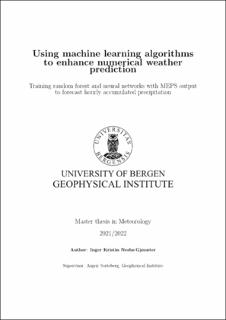Using machine learning algorithms to enhance numerical weather prediction
Master thesis
Permanent lenke
https://hdl.handle.net/11250/3045582Utgivelsesdato
2022-11-21Metadata
Vis full innførselSamlinger
- Master theses [105]
Sammendrag
In this master thesis machine learning algorithms have been used in an effort to enhance numerical weather prediction. The learning algorithms used are random forest to provide a no precipitation/precipitation classification, and neural networks to predict the numerical value of hourly accumulated precipitation amount. Both algorithms has been trained on numerical model output, specifically output from the numerical model MEPS (MetCoOp ensemble prediction system) for two locations with distinctly different precipitation frequencies, Florida, Bergen and Blindern Oslo. After the data was classified by the random forest model, a neural network was trained for each individual class (i.e class 0: no precipitation, class 1: precipitation). The neural network show promising results according to the verification metrics, which suggest an improvement compared to MEPS. When splitting the forecast into categories of hourly accumulated precipitation amount (rain rates) the verification metrics show a good performance of no rain and light rain, however, it revealed a systematic underprediction of medium and heavy (hourly) rain rates at both locations. This underprediction is even more severe for Blindern, Oslo than for Florida, Bergen, illustrating the importance of enough data in machine learning. Though the algorithms was provided many samples, not enough of these samples actually meet the threshold of hourly rain rate RRhourly ≥ 0.1mm/h , and thus there is not enough precipitation samples for the algorithms to capture the true distribution of the observed precipitation. MEPS also struggles to capture these hourly rain rates, though the numerical model manages to do so significantly better than the neural networks. Hence, the verification metrics favors the neural networks for RRhourly ∈ [0, 2.5⟩ mm/h , and MEPS for RRhourly ∈ [2.5, ∞⟩ mm/h . Visual inspections of plots of the predictions from the neural networks and MEPS, together with the observed precipitation show the same underprediction, which for Blindern is severe enough that visually one can deem MEPS a better fit to the observations. For Florida however, it is not clear which is better, and though the neural network is not obviously better by any means, it is very much comparable to MEPS concerning light rain (RRhourly ∈ [0, 2.5⟩ mm/h ), which in itself is an accomplishment that yield promise for future research.
